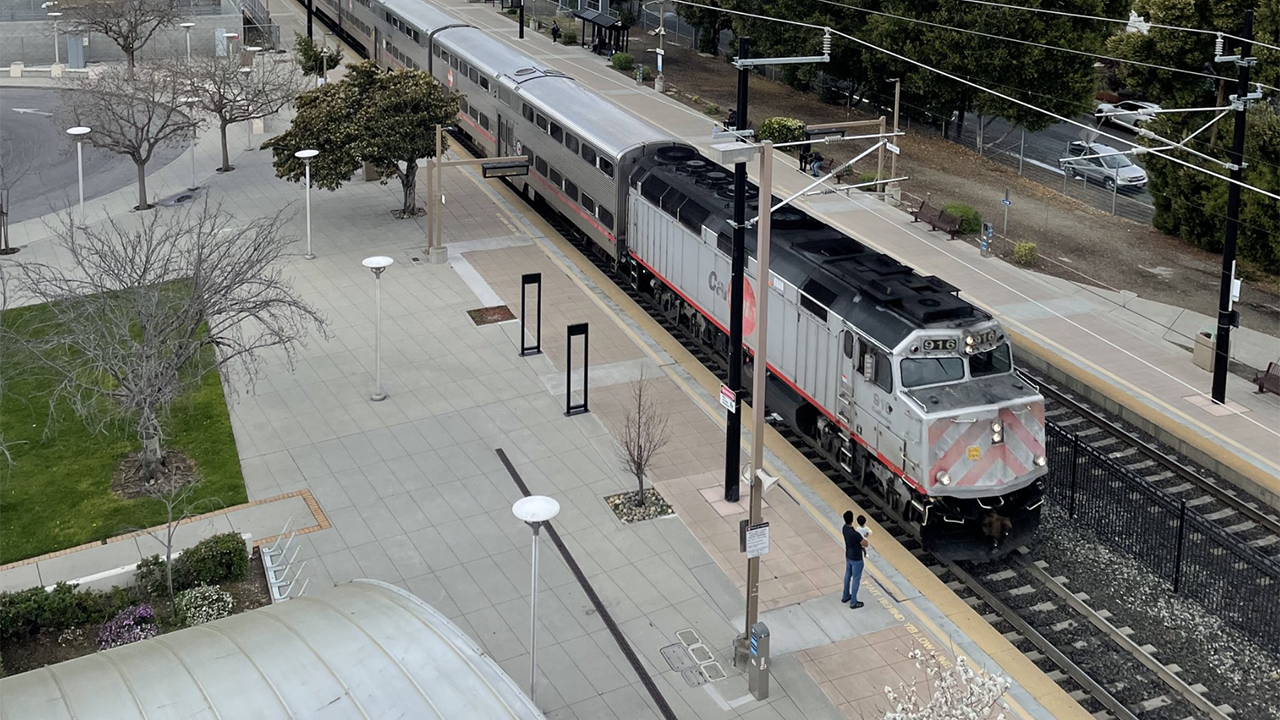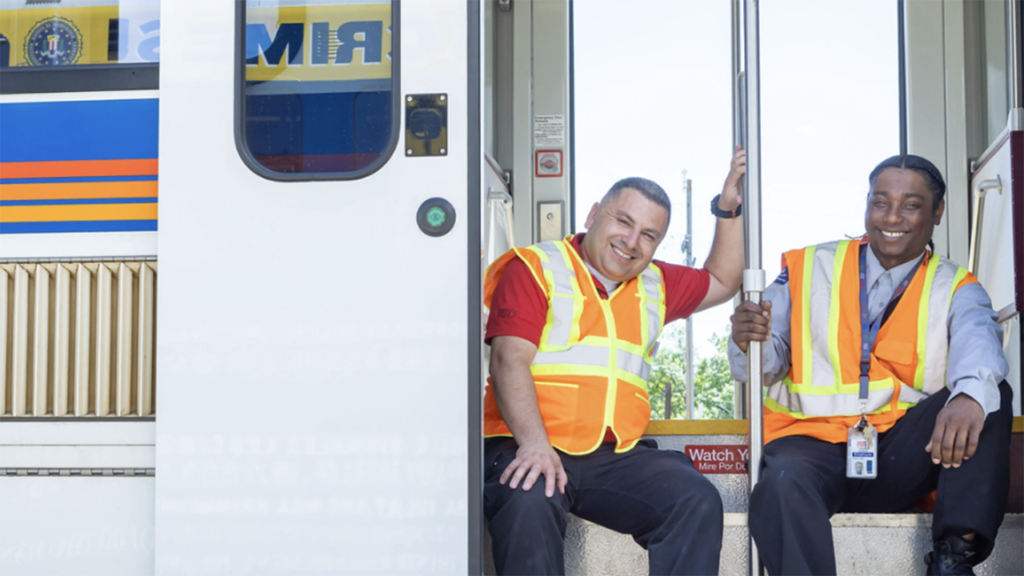
Transit Briefs: Caltrain, Denver RTD, KC Streetcar
Written by Marybeth Luczak, Executive Editor
Caltrain is shipping 32 of its nearly 40-year-old Nippon Sharyo gallery cars (pictured) for storage in Petaluma, Calif., where they will await a buyer. The transit agency, which had not recently used the cars in revenue service, is making room for its new electric fleet from Stadler, slated to start running this fall. (Caltrain Photograph)
California’s Caltrain retires 32 gallery cars to make room for its new electric fleet. Also, Denver (Colo.) Regional Transportation District (RTD) kicks off a customer service pilot program; and Missouri’s Kansas City (KC) Streetcar Authority releases the results of its 2023 rider satisfaction survey.
Caltrain
Caltrain on March 26 reported shipping 32 of its nearly 40-year-old Nippon Sharyo gallery cars for storage with Sonoma-Marin Area Rail Transit (SMART) in Petaluma, Calif., until a buyer is found. Retirement of these cars, which had not been used recently in revenue service, will make room for Caltrain’s new electric fleet from Stadler.
The commuter rail agency, which is operated by the Peninsula Corridor Joint Powers Board and provides service from San Francisco to San Jose, began running the Nippon Sharyo cars in 1985, when the agency was still operated by Caltrans. The rest of the Nippon Sharyo cars will be retired when electric service starts this fall, according to Caltrain.
Caltrain’s electric service is arriving two years later than planned. The commuter rail agency’s $2.4 billion electrification project is upgrading and electrifying its double-track system from the 4th and King Station in San Francisco to the Tamien Station in San Jose and replacing trains. Caltrain awarded Stadler a $551 million contract to supply 16 six-car EMUs in August 2016 with an option to extend these sets to seven-car trains exercised in December 2018. The 110-mph-capable trainsets have been built at the manufacturer’s plant in Salt Lake City, and there are options worth $385 million under the original contract to supply up to 96 additional railcars. The Electric Multiple Units (EMU) will replace F40 diesel locomotives—approximately 75% of Caltrain’s diesel fleet—which entered service in 1985. Its newer locomotives will be retained to operate the non-electrified Dumbarton extension and services south of Tamien.
Caltrain currently has eight of the eventual 23 electric trainsets on its property.
The proposed electrification service plan is slated to see weekday peak-hour trains go to 79 stations per hour, an increase from the current 66. Eleven stations would see four train arrivals hourly per direction, up from seven stations currently. Midday trains would cover 44 stations per hour, up from 34 today.
In other developments, Caltrain recently marked an EMU testing milestone and issued a Request for Information from property owners, managers or their qualified broker representatives to assist with identifying potential new office space for its headquarters.
Denver RTD

The Denver RTD Communications and Engagement management team is kicking off a six-month pilot program geared toward assisting riders, answering questions about the transit agency’s services, and gathering feedback. Starting next month, working in teams of two, managers will ride trains and buses, and visit stations and bus stops, to directly engage with riders and gain insight on how to improve their experience, Denver RTD reported March 27.
Wearing Denver RTD-branded vests, the managers will be available to show riders how to sign up for Service Alerts, answer questions about how to use the Next Ride and Transit Watch apps, provide information about rail lines and bus routes, and discuss the agency’s near-term construction and maintenance projects, for example.
Following the pilot program’s conclusion in September, Denver RTD will assess its overall impact on the rider experience and make plans for continuing it in the future.
In other developments, Denver RTD recently launched an elevator pilot program and joined the White House’s “Challenge to Save Lives from Overdose” initiative, and will begin the first phase of light rail reconstruction project in May.
KC Streetcar
The KC Streetcar Authority recently published the results of its 2023 Rider Satisfaction Survey, which was conducted last fall by the ETC Institute.

The on-board survey, which took place in November 2023 and garnered responses from 880 riders, was available in traditional print and digital formats, in both English and Spanish. The collected data covered frequency of use, trip purpose, satisfaction with transit characteristics, method of accessing transit information, and household and demographic details.
According to the KC Streetcar Authority, key survey findings include:
- 93% of respondents expressed that they were “Very Satisfied” or “Satisfied” with streetcar service, compared with 6% “Neutral,” and 1% “Dissatisfied” or “Very Dissatisfied.”
- The highest ratings of satisfaction (“Satisfied” and “Very Satisfied”) were observed in categories such as ease of use (96%); access to stops (93%); condition of stops (92%); cleanliness of streetcars (92%); reliability of service (92%); personal safety while riding (91%); and professionalism and friendliness of staff (91%).
- 30% of respondents indicated that the reliability of service is most important, followed by on-schedule performance, professionalism and friendliness of operator and staff, and ease of use; each at 20%.
KC Streetcar Authority said the survey data also revealed that:
- 80% of respondents are residents of the Kansas City metropolitan area, “highlighting the local significance of the streetcar service.”
- 65% of respondents self-identified as “choice riders,” indicating that they have access to a personal vehicle but opt for streetcar transportation.
- The largest percentage of riders are those ages 25-34 years old, with 35% of riders being over the age of 45.
- Nearly 40% of regular riders use KC Streetcar four or more days each week.
- In terms of trip purpose, 31% of weekday streetcar riders reported using the service for employment-related trips.
- More than 61% of respondents indicated spending money downtown, “underscoring the streetcar’s role in stimulating economic activity and supporting local businesses.”
“Our team strives to be the very best, and we can only do that through good data and regular user feedback,” said Tom Gerend, Executive Director of the KC Streetcar Authority. “The strong satisfaction ratings indicate we are doing a lot of things right, but there is always room for improvement.”
Separately, KC Streetcar last month began testing the first of eight new CAF USA-manufactured vehicles. They will be used to support operation of the Main Street and Riverfront extensions, ultimately connecting the University of Missouri-Kansas City (UMKC) to the Berkley Riverfront.



